Scutellarin
 | |
| Names | |
|---|---|
| Other names
Breviscapine; Breviscapin; Scutellarein-7-glucuronide; Scutellarein-7beta-D-glucuronide; Scutellarein-7beta-D-glucuronoside; Scutellarein-7-O-beta-D-glucuronide; 7-(β-D-glucopyranuronosyloxy)-5,6-dihydroxy-2-(4-hydroxyphenyl)-4H-1-benzopyran-4-one | |
| Identifiers | |
| 3D model (JSmol) |
|
| ChEBI | |
| ChemSpider | |
| PubChem CID |
|
| UNII | |
| |
| |
| Properties | |
| C21H18O12 | |
| Molar mass | 462.36 g/mol |
| Hazards | |
| Lethal dose or concentration (LD, LC): | |
| LD50 (median dose) |
1314 mg/kg (mouse, intravenous) [1] |
| Except where otherwise noted, data are given for materials in their standard state (at 25 °C [77 °F], 100 kPa). | |
| | |
| Infobox references | |
Scutellarin is a flavone, a type of phenolic chemical compound. It can be found in Scutellaria barbata and S. lateriflora. The determination of the structure of scutellarin took Guido Goldschmiedt many years: after the first publication on that topic in 1901, only in 1910 he managed to obtain enough starting material for more detailed studies.
Scutellarin has been shown to induce apoptosis of ovarian and breast tumor cells in vitro.
References
- ↑ Zhongcaoyao (1983): Chinese Traditional and Herbal Medicine. Bd. 14, S. 33.
This article is issued from
Wikipedia.
The text is licensed under Creative Commons - Attribution - Sharealike.
Additional terms may apply for the media files.